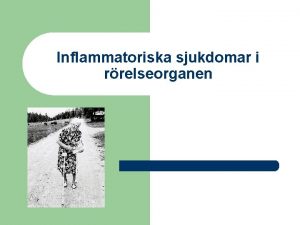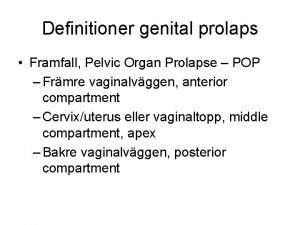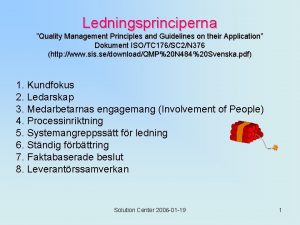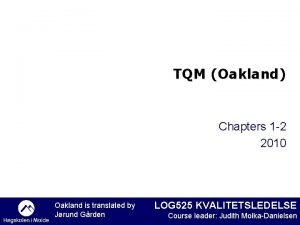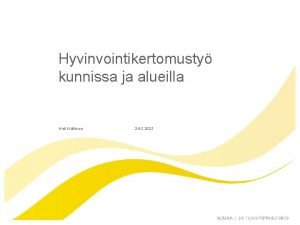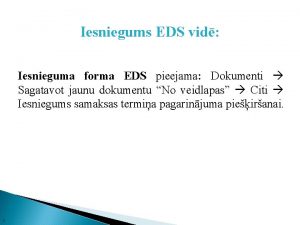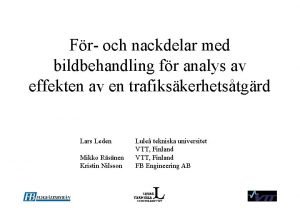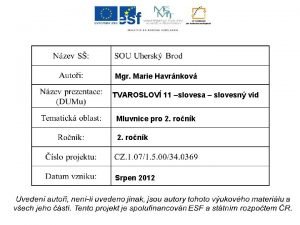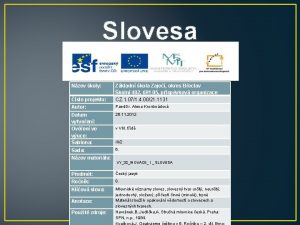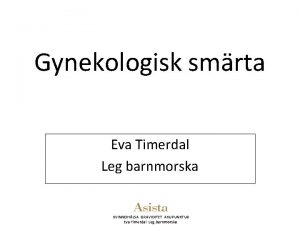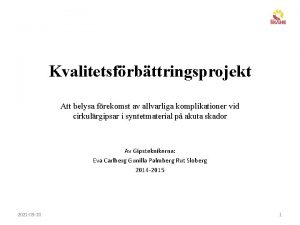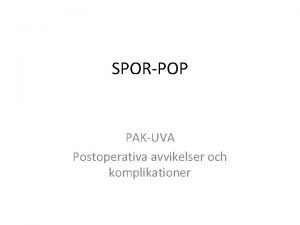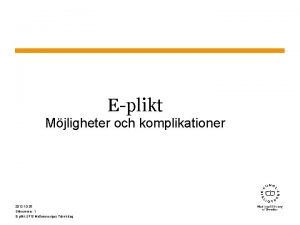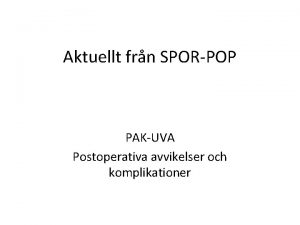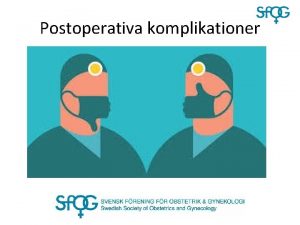Komplikationer vid gynekologisk kirurgi Eva Uustal Dagens punkter



























- Slides: 27

Komplikationer vid gynekologisk kirurgi Eva Uustal

Dagens punkter • Historik om prolaps och inkontinenskirurgi • Evidensläget • Omvärldshändelser • Hur ligger vi till i Sverige • Hur ser vi framåt

Behandling Ansträngningsinkontinens • Viktreduktion vid övervikt • Bäckenbottenträning • Båge eller ring • Farmaka – serotonin- och noradrenalinåterupptagshämmare? • Periuretral injektionsbehandling • Operation – Tension free vaginal tape (TVT)

Före 1997 var Burchplastiken den minst dåliga av ett 20 -tal operationsmetoder

A multicenter study of tension-free vaginal tape (TVT) for surgical treatment of stress urinary incontinence. Ulmsten U 1, Falconer C, Johnson P, Jomaa M, Lannér L, Nilsson CG, Olsson I. Int Urogynecol J Pelvic Floor Dysfunct. 1998; 9(4): 210 -3. • The aim of the study was to evaluate the safety and efficacy of TVT (tension-free vaginal tape) for the surgical treatment of stress urinary incontinence. The design was a prospective open multicenter study including six centers, each operating an approximately 20 patients. In total 131 patients suffering from genuine stress incontinence were included. They were followed for at least 1 year using a specific protocol for objective and subjective evaluation of the outcome. All patients underwent the operation under local anesthesia. Mean operation time was 28 minutes (range 19 -41 minutes); 119 (91%) of the patients were cured according to the protocol and another 9 (7%) were significantly improved. There were 3 (2%) failures. The majority of the patients (about 90%) were operated upon on a day-care basis, which implied that they were released from the hospital within 24 hours, with no postoperative catheterization. No defect healing and no tape rejection occurred. Three patients needed an indwelling catheter for 3 days. In 1 patient catheterization was necessary for more than 10 days. Two uncomplicated hematomas and one uncomplicated bladder perforation occurred. Based on the results, we conclude that TVT is a safe and effective ambulatory procedure for surgical treatment of genuine stress urinary incontinence


Updated Systematic Review and Meta-analysis of the Comparative Data on Colposuspensions, Pubovaginal Slings, and Midurethral Tapes in the Surgical Treatment of Female Stress Urinary Incontinence. Fusco F Eur Urol. 2017 Oct; 72(4): 567 -591. doi: 10. 1016/j. eururo. 2017. 04. 026. Epub 2017 May 4. • CONTEXT: Retropubic (RP-TVT) and transobturator miurethral (TO-TVT) midurethral sling (MUS) are popular surgical treatments for female stress urinary incontinence. The long-term efficacy and safety of the procedures is still a topic of intense clinical research and several randomised controlled trials (RCTs) have been published in the last years OBJECTIVE: To evaluate the efficacy and safety of MUS compared with other surgical treatments for female stress urinary incontinence. • EVIDENCE ACQUISITION: A systematic review and meta-analysis of the literature was performed using the Medline, Scopus, and Web of Science databases to update our previously published analyses. • EVIDENCE SYNTHESIS: Twenty-eight RCTs were identified. In total, the meta-analyses included 15 855 patients. Patients receiving MUS had significantly higher overall (odds ratio [OR]: 0. 59, p=0. 0003) and objective (OR: 0. 51, p=0. 001) cure rates than those receiving Burchcolposuspension. Patients undergoing MUS and pubovaginal slings had similar cure rates. Patients treated with RTTVT had higher subjective (OR: 0. 83, p=0. 03) and objective (OR: 0. 82, p=0. 01) cure rates than those receiving TO-TVT. However, the latter had a lower risk of intraoperative bladder or vaginal perforation (OR: 2. 4, p=0. 0002), pelvic haematoma (OR: 2. 61, p=0. 002), urinary tract infections (OR: 1. 31, p=0. 04) and voiding lower urinary tract symptoms (OR: 1. 66, p=0. 002). Sensitivity analyses limited to RCTs with follow-up durations >60 mo demonstrated similar outcomes for RP-TVT and TO-TVT. No significant differences in efficacy were identified comparing inside-to-out and outside-to-in TO-TVT but vaginal perforations were less common with the former (OR: 0. 21, p=0. 0002). • CONCLUSIONS: The present analysis confirms the superiority of MUS over Burch colposuspension. The studies comparing insertion of RT-TVT and TO-TVT showed higher subjective and objective cure rates for the RP-TVT but at the cost of higher risks of some complications and voiding lower urinary tract symptoms. Efficacy of inside-out and outside-in techniques of TOTVT insertion was similar, although the risk of vaginal perforation was lower in the inside-to-out TO-TVT. • PATIENT SUMMARY: Retropubic and transobturator midurethral slings are a popular treatment for female stress urinary incontinence. The available literature suggest that those slings are either more effective or safer than other older surgical procedures. Retropubic tapes are followed with slightly higher continence rates as compared with the transobturator tapes but are associated with higher risk of intra- and postoperative complications.

Ålder, övervikt, trängningar och tidigare kirurgi spelar roll för resultatet vid slyngplastik • En kvinna med 4 riskfaktorer har 35 % chans att bli kontinent 1 år efter slyngplastik. • Motsvarande chans är 90 % för en kvinna utan riskfaktorer

Alla mynt har en baksida…. • 3000 -5000 ingrepp per år i Sverige sedan 20 år • Oerhört många kvinnor med förbättrad livskvalitet • Sällsynta komplikationer men då stor påverkan på livet • Blåstömningspåverkan • Smärtor • Urinvägsinfektioner • Band som kommer fram genom slidan, vaginalväggen uretra, blåsan

Association Between the Amount of Vaginal Mesh Used With Mesh Erosions and Repeated Surgery After Repairing Pelvic Organ Prolapse and Stress Urinary Incontinence. Chughtai B JAMA Surg. 2017 • IMPORTANCE: Mesh, a synthetic graft, has been used in pelvic organ prolapse (POP) repair and stress urinary incontinence (SUI) to augment and strengthen weakened tissue. Polypropylene mesh has come under scrutiny by the US Food and Drug Administration. • OBJECTIVE: To examine the rates of mesh complications and invasive reintervention after the placement of vaginal mesh for POP repair or SUI surgery. • DESIGN, SETTING, AND PARTICIPANTS: This investigation was an observational cohort study at inpatient and ambulatory surgery settings in New York State. Participants were women who underwent transvaginal repair for POP or SUI with mesh between January 1, 2008, and December 31, 2012, and were followed up through December 31, 2013. They were divided into the following 4 groups based on the amount of mesh exposure: transvaginal POP repair surgery with mesh and concurrent sling use (vaginal mesh plus sling group), transvaginal POP repair with mesh and no concurrent sling use (vaginal mesh group), transvaginal POP repair without mesh but concurrent sling use for SUI (POP sling group), and sling for SUI alone (SUI sling group). • MAIN OUTCOMES AND MEASURES: The primary outcome was the occurrence of mesh complications and repeated invasive intervention within 1 year after the initial mesh implantation. A time-to-event analysis was performed to examine the occurrence of mesh erosions and subsequent reintervention. Secondary analyses of an age association (<65 vs ≥ 65 years) were conducted. • RESULTS: The study identified 41 04 women who underwent 1 of the 4 procedures. The mean (SD) age of women at their initial mesh implantation was 56. 2 (13. 0) years. The highest risk of erosions was found in the vaginal mesh plus sling group (2. 72%; 95% CI, 2. 31%-3. 21%) and the lowest in the SUI sling group (1. 57%; 95% CI, 1. 41%-1. 74%). The risk of repeated surgery with concomitant erosion diagnosis was also the highest in the vaginal mesh plus sling group (2. 13%; 95% CI, 1. 76%-2. 56%) and the lowest in the SUI sling group (1. 16%; 95% CI, 1. 03%-1. 31%). • CONCLUSIONS AND RELEVANCE: The combined use of POP mesh and SUI mesh sling was associated with the highest erosion and repeated intervention risk, while mesh sling alone had the lowest erosion and repeated intervention risk. There is evidence for a dose-response relationship between the amount of mesh used and subsequent mesh erosions, complications, and invasive repeated intervention

Surgical treatment for urinary incontinence in women - Danish nationwide cohort studies. Hansen MF 1. Dan Med J. 2018 Feb; 65(2). pii: B 5447. • Study I: The study provided physicians with a representative evaluation of the rate of reoperations after different surgical procedures for UI. The observation that TOT was associated with a significantly higher risk of reoperation than TVT is novel in the literature and has important implications for both surgeons and patients when they consider surgical options for UI. • Study II: The majority of women had reoperation at the same department as the primary synthetic MUS. Fewer treatment modalities were in use at low volume departments compared with high volume departments. It seems appropriate in the absence of evidence for the best treatment after failed synthetic MUSs, that women are referred to highly specialized departments for diagnosing and treatment. • Study III: This national population-based cohort study represented cure among women who had UIT in an everyday life setting. Results seemed to be in the lower end of the spectrum compared to the literature. A learning curve for UIT indicated that the treatment should be restricted to fewer hands to improve the surgical education and consequently be a success for women with UIT. The severity of UI was a strong predictor for a lower degree of cure. Similarly, the use of antimuscarinic drug preoperatively decreased the likelihood of cure indicating that women with severe MUI or UUI also have less chance of cure.

• Long-term Rate of Mesh Sling Removal Following Midurethral Mesh Sling Insertion Among Women With Stress Urinary Incontinence JAMA. 2018 Oct 23; 320(16): 1659 -1669. doi: 10. 1001/jama. 2018. 14997 Gurol-Urganci I , 1, 2 • IMPORTANCE: There is concern about outcomes of midurethral mesh sling insertion for women with stress urinary incontinence. However, there is little evidence on long-term outcomes. • OBJECTIVE: To examine long-term mesh removal and reoperation rates in women who had a midurethral mesh sling insertion for stress urinary incontinence. • DESIGN, SETTING, AND PARTICIPANTS: This population-based retrospective cohort study included 95 57 women aged 18 years or older who had a first-ever midurethral mesh sling insertion for stress urinary incontinence in the National Health Service hospitals in England between April 1, 2006, and December 31, 2015. Women were followed up until April 1, 2016. • EXPOSURES: Patient and hospital factors and retropubic or transobturator mesh sling insertions. • MAIN OUTCOMES AND MEASURES: The primary outcome was the risk of midurethral mesh sling removal (partial or total) and secondary outcomes were reoperation for stress urinary incontinence and any reoperation including mesh removal, calculated with death as competing risk. A multivariable Fine-Gray model was used to calculate subdistribution hazard ratios as estimates of relative risk. • RESULTS: The study population consisted of 95 57 women (median age, 51 years; interquartile range, 44 -61 years) with first midurethral mesh sling insertion, including 60 94 with retropubic insertion and 34 63 with transobturator insertion. The median follow-up time was 5. 5 years (interquartile range, 3. 2 -7. 5 years). The rate of midurethral mesh sling removal was 1. 4% (95% CI, 1. 3%-1. 4%) at 1 year, 2. 7% (95% CI, 2. 6%-2. 8%) at 5 years, and 3. 3% (95% CI, 3. 2%-3. 4%) at 9 years. Risk of removal declined with age. The 9 -year removal risk after transobturator insertion (2. 7% [95% CI, 2. 4%-2. 9%]) was lower than the risk after retropubic insertion (3. 6% [95% CI, 3. 5%-3. 8%]; subdistribution hazard ratio, 0. 72 [95% CI, 0. 62 -0. 84]). The rate of reoperation for stress urinary incontinence was 1. 3% (95% CI, 1. 3%-1. 4%) at 1 year, 3. 5% (95% CI, 3. 4%-3. 6%) at 5 years, and 4. 5% (95% CI, 4. 3%4. 7%) at 9 years. The rate of any reoperation, including mesh removal, was 2. 6% (95% CI, 2. 5%-2. 7%) at 1 year, 5. 5% (95% CI, 5. 4%-5. 7%) at 5 years, and 6. 9% (95% CI, 6. 7%-7. 1%) at 9 years. • CONCLUSIONS AND RELEVANCE: Among women undergoing midurethral mesh sling insertion, the rate of mesh sling removal at 9 years was estimated as 3. 3%. These findings may guide women and their surgeons when making decisions about surgical treatment of stress urinary incontinence

Många kvinnor opererades många gånger • Stort lidande • Kvinnor med återfall upplevde att de gjort fel, var ”slappa”

Nätförstärkning

Näten, äntligen(? ) • Nätförstärkningen kom från bukväggsbråckkirurgin • Uppfattade till en början som lösningen på allt • Ekonomiska intressen drev på användningen


Erosion i vagina 1 av 10

Changed women: the long-term impact of vaginal mesh complications. • Female Pelvic Med Reconstr Surg. 2014 May-Jun; 20(3): 131 -6. doi: 10. 1097/SPV. 000000083. • Dunn GE 1, Hansen BL, Egger MJ, Nygaard I, Sanchez-Birkhead AC, Hsu Y, Clark L. • OBJECTIVES: The aim of this study was to describe how women experience vaginal mesh complications after optimized tertiary care level treatment. • METHODS: We conducted telephone interviews in 2012 with women at least 6 months after presentation to our tertiary care clinic between 2006 and 2011 for complications related to vaginal mesh and transcribed verbatim responses to 2 open-ended questions about their experiences surrounding vaginal mesh complications. We analyzed data using qualitative description with low-inference interpretation in a team-based setting followed by consensus meetings to arrive at descriptive trajectories of their experiences. • RESULTS: Of 111 women, we successfully contacted 88, and 84 agreed to the interview. The mean duration from index mesh surgery to interview was 4. 5 years, and the mean duration from presentation to our clinic for complications to the interview was 2. 3 years. The effects of mesh complications caused both physical and emotional pain, in addition to the discomfort of the original pelvic floor dysfunction. The women's experiences followed 1 of 3 recovery trajectories. In "cascading health problems, " the women experienced a spiral of health problems, anxiety, and desperation. In "settling for a new normal, " the women who once considered themselves healthy now believed that they are unhealthy and worked to adjust to their degraded health status. In "returning to health, " the women described a return to health. The women still symptomatic discharged from tertiary care clinic expressed hopelessness and abandonment. • CONCLUSIONS: Concomitant with ongoing research to improve the safety of vaginal mesh procedures, there must be dedicated efforts to develop and study a range of therapies for holistically treating women with mesh complications

Hur ser det ut internationellt • https: //www. theguardian. com/science/2017/dec/12/new-zealandbans-vaginal-mesh-implants • https: //www. rcog. org. uk/globalassets/documents/guidelines/safetyalerts/appendixassuringcompetencyofdoctors. pdf

Prolapsnäten minskade i användning • Förbjöds helt i USA • Stora tillverkare slutade producera


Komplikations- och åtgärdskoder släpar efter

• https: //www. expressen. se/nyheter/ramlar-ut-sma-bitar-av-natet-narjag-gar-pa-toaletten/

Vad har vi för reglemente i Sverige? • Inkontinens: • https: //www. socialstyrelsen. se/Site. Collection. Documents/nationellaindikationer-operation-anstrangningsinkontinens-kvinnor. pdf • Prolaps: • UR-Args prolapsrapport från 2009

Baroness Cumberledges villkor för inkontinensnätanvändning i UK kontra hur det ser ut i Sverige • • Surgeons should only undertake operations for SUI if they are appropriately trained, and only if they undertake operations regularly; (NMI!) • Surgeons report every procedure to a national database; • A register of operations is maintained to ensure every procedure is notified and the woman identified who has undergone the surgery; • Reporting of complications via (Medicines & Healthcare products Regulatory Agency ) “Läkemedelsverket” MHRA is linked to the register; • Identification and accreditation of specialist centres for SUI mesh procedures, for removal procedures and other aspects of care for those adversely affected by surgical mesh; (nivåstrukturering? ) • NICE guidelines on the use of mesh for SUI are published. https: //www. nice. org. uk/news/article/nice-says-nonsurgical-options-should-be-offered-first-for-stress-urinaryincontinence-or-pelvic-organ-prolapse

Hur ser det ut i Gynopregistret: • Specialrapport 2017 från Gynop, Malin Kallenfeldt : • I denna studie var prevalensen av allvarliga komplikationer 3. 9%. De vanligast förekommande kategorierna av allvarliga komplikationer totalt sett var Urinvägar (blåsskada, uretärskada och blåstömningsbesvär), Infektion (bukvägg), Blödning (annat) och Smärta (smärta UNS). Implantat endast 0. 01%- inte allvarliga? För tidigt ? Ej rapporterade? • http: //www 2. gynop. se/wpcontent/uploads/2018/02/Gyn. Op%C 3%85 terrapport. Allvarligakomplikation er 170915. pdf

Alla ingrepp medför risk för komplikationer • Patientinformation • Allvarliga komplikationer ska informeras om även om de är sällsynta • Det är svårare att informera rätt än att operera • Riskbeteende finns hos både hos kirurger och patienter • Komplikationshantering är inte bara kirurgi • Psykosocialt stöd, ”krisgrupp”, multidisciplinärt team, bäckensmärtkompetens, visa patienten att vi har en plan • Hur kan vi utveckla registret för att lära oss om det bästa sättet att hantera komplikationer? • Vi behöver lära oss av historien • Vi behöver lära oss av patienterna
 Gynekologisk kirurgi
Gynekologisk kirurgi Muskelreumatism kost
Muskelreumatism kost Vaginalt enterocele
Vaginalt enterocele Segmentering
Segmentering Dagens manna
Dagens manna Dagens kluring
Dagens kluring Omstickning kirurgi
Omstickning kirurgi Hageløft uden kirurgi
Hageløft uden kirurgi Apikal kirurgi
Apikal kirurgi Demings 14 punkter
Demings 14 punkter Demings 14 punkter
Demings 14 punkter Woodrow wilsons 14 punkter
Woodrow wilsons 14 punkter Heli hätönen
Heli hätönen Heli uustal
Heli uustal Heli jaago
Heli jaago Heli uustal
Heli uustal Heli uustal
Heli uustal Timo uustal
Timo uustal Heli uustal
Heli uustal Dokonavý nedokonavý
Dokonavý nedokonavý Eds.vid
Eds.vid är av vikt vid bildbehandling
är av vikt vid bildbehandling Slovesa dokonavá a nedokonavá
Slovesa dokonavá a nedokonavá Vid dokonavy vs nedokonavy
Vid dokonavy vs nedokonavy Vidova dvojica
Vidova dvojica Words with the root culp
Words with the root culp Opačný vid
Opačný vid Trajni i učestali glagoli
Trajni i učestali glagoli

